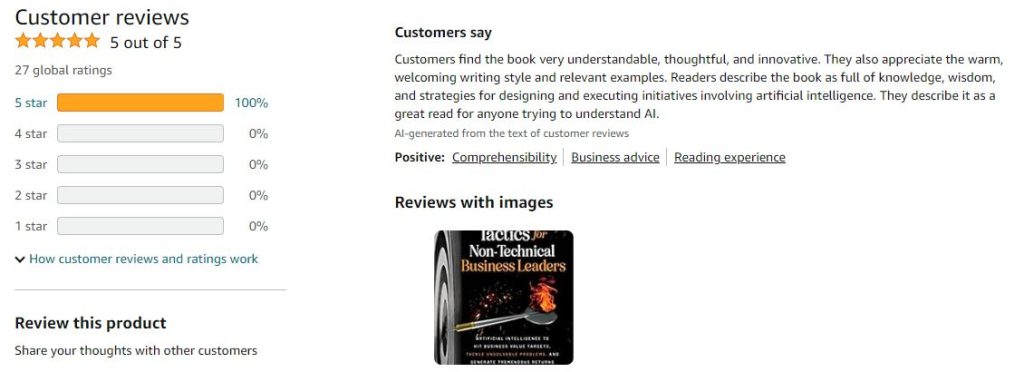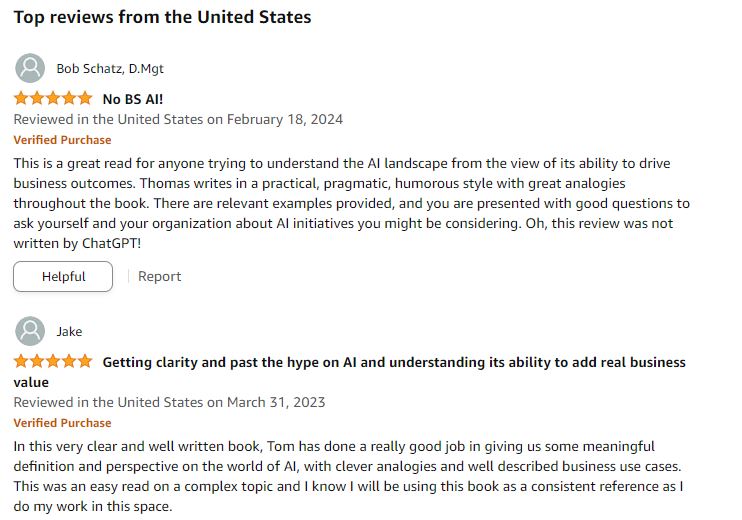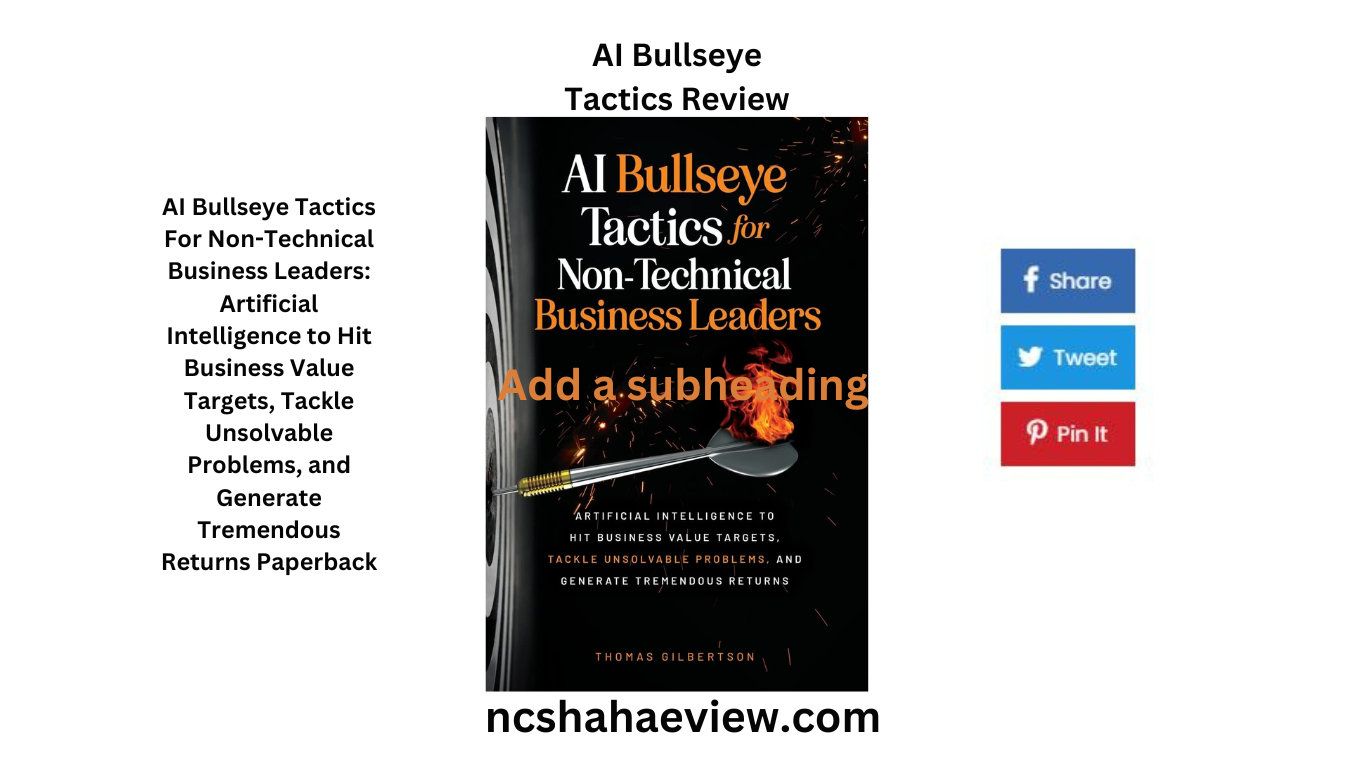Introduction
Get Real-World Business Results with AI Bullseye—Minus the Hype
AI Bullseye experts often overwhelm you with tech jargon and flashy presentations. They talk about automation, analytics, algorithms, and machine learning, using hype and fear to control you. This slows your AI progress and fills their pockets. It’s time to break free from the hype and start reaping the benefits of AI without any technical expertise!
In AI Bullseye Tactics for Non-Technical Business Leaders, AI expert Thomas Gilbertson shares real-life stories from his experience with Fortune 10 companies. He reveals 12 core principles for deploying AI effectively, changing how you think about business value from AI forever. While others debate what AI is, Gilbertson shows what AI can do for your business and career.
You’ll learn how to identify AI opportunities that drive profits and reduce costs across industries. Gilbertson will guide you in building a top-notch AI team, debunking myths about required skills. He simplifies AI techniques into five useful categories and teaches the “secret sauce” question to uncover AI opportunities in your organization. Avoid 60 common pitfalls that hinder AI success. This tactical, user-friendly book bypasses the hype, offering secrets to gaining a competitive edge. Whether you’re a CEO, manager, entrepreneur, or MBA, AI Bullseye Tactics for Non-Technical Business Leaders gives you the path and confidence to apply AI in your business today.
Product details
ASIN : B0BPNSFVS7
Publisher : Grape Publishing (January 17, 2023)
Language : English
Paperback : 238 pages
ISBN-13 : 979-8986843513
Item Weight : 11.5 ounces
Dimensions : 6 x 0.54 x 9 inches
Best Sellers Rank: #332,285 in Books (See Top 100 in Books)
100 in Business Intelligence Tools
249 in Computers & Technology Industry
607 in Artificial Intelligence & Semantics
AI Bullseye Tactics For Non-Technical Business Leaders : About the author

Thomas Gilbertson is a seasoned AI-for-business expert and trailblazing business leader. He currently serves as senior director of AI delivery and innovation with Optum Technology, a part of UnitedHealth Group. As a health care innovation executive, he harnesses advanced AI technologies to transform business processes and enhance customer experiences.
Tom has been active in cutting-edge technologies for over three decades. With a degree in interdisciplinary science from Rensselaer Polytechnic Institute (RPI), he started as an entrepreneur and spent the next decade leading a boutique consulting firm, delivering rapid value to large organizations. For the last 20 years, he has led health care technology teams, including managing technology capital investments of over $200 million annually.
From scratch, Tom created a world-class AI and machine learning team that completed 72 AI projects in a two-year period. A senior inventor with four issued and pending AI health care patents, Tom has channeled his experience to make him a sought-after public speaker for non-technical business leaders on how to make AI work.
Tom lives in Connecticut with his wife and two daughters. He enjoys spending time with his family, watching horse racing, and is a self-proclaimed lousy golfer. Learn more at


Understanding Artificial Intelligence
What is AI?
AI refers to the simulation of human intelligence processes by machines, especially computer systems. These processes include learning (the acquisition of information and rules for using the information), reasoning (using the rules to reach approximate or definite conclusions), and self-correction.
Key Components of AI
- Machine Learning (ML): Enables systems to learn and improve from experience without being explicitly programmed.
- Natural Language Processing (NLP): Allows machines to understand and interpret human language.
- Computer Vision: Enables machines to interpret and make decisions based on visual inputs.
AI vs. Machine Learning vs. Deep Learning
While AI is the broad concept of machines being able to carry out tasks in a way that we would consider “smart,” machine learning is a subset of AI that allows machines to learn from data. Deep learning, in turn, is a subset of machine learning involving neural networks with many layers, enabling advanced pattern recognition.
Why AI Matters for Business
Transformative Potential of AI
AI has the power to transform businesses by automating routine tasks, providing deep insights through data analysis, enhancing customer experiences, and driving innovation. For non-technical leaders, embracing AI means opening doors to unprecedented efficiency and growth.
Case Studies of AI Success
Companies like Amazon, Google, and Netflix have set the benchmark for AI implementation, using it to personalize user experiences, predict customer behavior, and optimize logistics. These success stories illustrate the transformative impact AI can have on business operations and strategy.
AI’s Impact on Various Industries
From healthcare and finance to retail and manufacturing, AI is revolutionizing how industries operate. In healthcare, AI is being used for predictive analytics and personalized medicine. In finance, AI algorithms are transforming trading strategies and risk management.
AI Bullseye Tactics for Business Value
Identifying Business Value Targets
To effectively leverage AI, start by identifying the key areas where AI can drive the most value. These might include improving customer service, optimizing supply chains, or enhancing product development.
Leveraging AI for Maximum Impact
Once the targets are identified, apply AI tools and techniques that align with these goals. For example, use NLP for customer service chatbots or predictive analytics for inventory management.
Prioritizing AI Initiatives
Prioritize AI initiatives based on their potential impact and feasibility. Start with projects that have clear, measurable benefits and can be implemented with available resources.
Tackling Unsolvable Problems with AI
Complex Problems AI Can Address
AI excels at solving problems that are too complex for traditional methods. These include large-scale data analysis, pattern recognition, and predictive modeling.
Examples of AI Solving Tough Challenges
AI has been used to decode complex genetic data, predict market trends, and even diagnose diseases with higher accuracy than human doctors.
How to Implement AI for Problem-Solving
Implementing AI for problem-solving involves gathering the right data, choosing appropriate AI models, and continuously refining these models based on feedback and results.
Generating Tremendous Returns with AI
ROI of AI Investments
Investing in AI can yield significant returns through cost savings, increased efficiency, and enhanced decision-making capabilities.
Strategies for Maximizing Returns
Maximize returns by focusing on high-impact areas, continuously monitoring AI performance, and being willing to pivot strategies based on outcomes.
Measuring AI Success
Measure AI success through key performance indicators (KPIs) such as increased revenue, reduced operational costs, and improved customer satisfaction.
AI Tools and Technologies for Leaders
Essential AI Tools for Business
Some essential AI tools include:
- TensorFlow: For building and training AI models.
- IBM Watson: For a variety of AI applications including NLP and machine learning.
- Azure AI: Microsoft’s suite of AI services and tools.
How to Choose the Right AI Tools
Choose AI tools based on your specific needs, budget, and the existing technical infrastructure. Consider scalability, ease of integration, and support services.
Integration of AI into Existing Systems
Ensure a smooth integration of AI by planning for data compatibility, employee training, and potential system upgrades.
Building an AI-Driven Culture
Encouraging AI Adoption Among Teams
Promote AI adoption by educating teams on its benefits, providing training, and fostering a culture of innovation and experimentation.
Training and Development
Invest in training programs that equip employees with the necessary skills to work with AI tools and data-driven decision-making processes.
Change Management for AI Implementation
Implement a change management strategy to address resistance, communicate the benefits of AI, and ensure a smooth transition.
Overcoming Challenges in AI Adoption
Common Barriers to AI Adoption
Common barriers include lack of understanding, resistance to change, and data privacy concerns.
Strategies to Overcome These Challenges
Overcome these challenges through education, transparent communication, and robust data governance policies.
Ensuring Smooth AI Integration
Plan for phased implementation, continuously monitor progress, and be prepared to make adjustments as needed.
Ethics and AI in Business
Ethical Considerations of AI
Ensure ethical use of AI by addressing issues such as data privacy, bias in AI models, and the impact of AI on employment.
Ensuring Responsible AI Use
Implement guidelines and policies for responsible AI use, including regular audits and transparency in AI decision-making processes.
Addressing Bias in AI Systems
Address bias by diversifying training data, employing fairness-aware algorithms, and continuously monitoring AI outputs.
Future Trends in AI for Business
Emerging AI Technologies
Keep an eye on emerging technologies such as quantum computing, edge AI, and autonomous systems that will shape the future of AI.
Future Applications of AI
Future applications may include more sophisticated AI-driven customer service, advanced predictive analytics, and fully automated supply chains.
Preparing for AI Advancements
Stay ahead by investing in ongoing learning, experimenting with new AI technologies, and being adaptable to change.
AI Bullseye : Price
Reasonable . Please Click Here
AI Bullseye : Conclusion
AI holds immense potential for business leaders to hit their value targets, solve complex problems, and generate substantial returns. By understanding AI, leveraging its tools and technologies, and fostering an AI-driven culture, non-technical leaders can ensure their businesses thrive in the age of artificial intelligence.
>>>As An Early Bird Click Here To Get AI Bullseye <<<
AI Bullseye Tactics For Non-Technical Business Leaders: Frequently Asked Questions And Answers
1. How can non-technical business leaders start implementing AI in their organizations?
Answer: Non-technical business leaders can start by identifying key business areas where AI can add value. Begin with small, manageable projects that demonstrate clear benefits. Partner with AI experts or consultants to guide the process and provide necessary technical expertise. Additionally, invest in training programs to help employees understand and work with AI tools effectively.
2. What are some common misconceptions about AI in business?
Answer: Common misconceptions include the belief that AI will replace human jobs entirely, that it’s only for tech-savvy companies, and that it’s prohibitively expensive. In reality, AI is designed to augment human capabilities, can be implemented in various industries, and offers scalable solutions that can fit different budgets.
3. What types of problems can AI help solve in a business setting?
Answer: AI can tackle a wide range of problems, including predictive analytics for market trends, automating repetitive tasks, enhancing customer service through chatbots, optimizing supply chains, and providing insights from large datasets. It excels at solving complex problems that require data analysis and pattern recognition.
4. How can businesses ensure the ethical use of AI?
Answer: To ensure ethical AI use, businesses should establish clear guidelines and policies. This includes maintaining transparency in AI decision-making processes, addressing data privacy concerns, regularly auditing AI systems for bias, and promoting diversity in AI training data. Encouraging a culture of responsibility and ethical awareness is also crucial.
5. What is the ROI of investing in AI, and how can it be measured?
Answer: The ROI of AI investments can be significant, encompassing cost savings, increased efficiency, enhanced decision-making, and improved customer satisfaction. ROI can be measured through various key performance indicators (KPIs) such as increased revenue, reduced operational costs, shorter project timelines, and higher customer retention rates.
6. What are some essential AI tools and technologies for non-technical leaders to consider?
Answer: Essential AI tools include:
- TensorFlow: For building and training AI models.
- IBM Watson: For a variety of AI applications including NLP and machine learning.
- Azure AI: Microsoft’s suite of AI services and tools.
These tools offer various functionalities that can help businesses leverage AI without requiring deep technical expertise.
7. How can businesses overcome common barriers to AI adoption?
Answer: Common barriers include lack of understanding, resistance to change, and data privacy concerns. Overcoming these barriers involves educating employees about the benefits of AI, promoting a culture of innovation, implementing robust data governance policies, and starting with small, demonstrable projects that can showcase AI’s value.
8. How does AI impact different industries?
Answer: AI impacts industries in various ways:
- Healthcare: Predictive analytics, personalized medicine, and improved diagnostic accuracy.
- Finance: Algorithmic trading, risk management, and fraud detection.
- Retail: Personalized recommendations, inventory management, and customer service chatbots.
- Manufacturing: Predictive maintenance, quality control, and supply chain optimization.
Each industry can leverage AI to improve efficiency, reduce costs, and enhance customer experiences.
9. What are the ethical considerations when using AI in business?
Answer: Ethical considerations include ensuring data privacy, preventing bias in AI models, and considering the impact of AI on employment. Businesses should strive for transparency in how AI systems make decisions, regularly audit their AI processes, and promote fairness and accountability in AI development and deployment.
10. What future trends in AI should business leaders be aware of?
Answer: Future trends include the rise of quantum computing, which will revolutionize data processing capabilities; edge AI, which brings AI processing closer to data sources; and autonomous systems that enhance automation. Keeping abreast of these advancements and investing in continuous learning will help businesses stay competitive.
11. How can AI improve customer service?
Answer: AI improves customer service through chatbots that provide instant responses, predictive analytics that anticipate customer needs, and personalized recommendations that enhance customer experiences. AI can also analyze customer feedback to identify areas for improvement.
12. How can businesses measure the success of AI implementations?
Answer: Success can be measured through KPIs such as increased sales, reduced operational costs, improved customer satisfaction, and faster decision-making processes. Regularly reviewing these metrics and adjusting strategies based on the results will help ensure successful AI implementations.
13. What role do data privacy and security play in AI adoption?
Answer: Data privacy and security are critical in AI adoption. Businesses must ensure that data used for AI is securely stored and handled in compliance with regulations. Implementing robust security measures and maintaining transparency with customers about data usage are essential for building trust and safeguarding sensitive information.
14. How can AI be integrated into existing business systems?
Answer: AI can be integrated by starting with pilot projects that connect AI tools with existing systems. It’s important to ensure data compatibility and invest in training employees to work with new technologies. Gradual integration and continuous monitoring will help smooth the transition.
15. What is the importance of fostering an AI-driven culture in a business?
Answer: Fostering an AI-driven culture encourages innovation, helps employees embrace new technologies, and drives continuous improvement. By promoting learning, providing training, and rewarding experimentation, businesses can create an environment where AI can thrive and deliver its full potential.
Learn About A I Agents Exposed Review
Affiliate Disclaimer:
I will receive affiliate commissions for reviews and promotions on this website. Always provide my honest assessment, relevant experience, and sincere opinion about genuine goods and services. I want to be as helpful as possible to help you choose what to buy, your opinion, and your perspective. I am prepare to provide you with my particulars and insights, facilitating your ongoing investment at an appropriate level. However, before any acquisition , ensure thorough verification of the outcomes and metrics . By clicking on links or purchasing items offered on this website, you can financially support me through affiliate commissions. “It’s important for you to understand that I receive compensation upon your purchase.”


[…] Emails Review-2024 : First-To-Market WordPress Autoresponder AI Bullseye Tactics For Non-Technical Business Leaders : A Comprehensive Review Architecting the Industrial Internet: The architect’s guide to designing Industrial […]
[…] Get Best Seller On ANY Platform WP Emails Review-2024 : First-To-Market WordPress Autoresponder AI Bullseye Tactics For Non-Technical Business Leaders : A Comprehensive Review Architecting the Industrial Internet: The architect’s guide to designing Industrial […]
[…] Get Best Seller On ANY Platform WP Emails Review-2024 : First-To-Market WordPress Autoresponder AI Bullseye Tactics For Non-Technical Business Leaders : A Comprehensive Review Architecting the Industrial Internet: The architect’s guide to designing Industrial […]
[…] Enterprise AI For Dummies 1st Edition Corel PaintShop Pro 2023 Ultimate | Powerful Photo Editing & Graphic Design Software + Creative Suite | Amazon Exclusive ParticleShop + 5 Brush Starter Pack [PC Download] AI Ebook Suite Review-2024 : Get Best Seller On ANY Platform WP Emails Review-2024 : First-To-Market WordPress Autoresponder AI Bullseye Tactics For Non-Technical Business Leaders : A Comprehensive Review […]
[…] Learn About AI Bullseye Tactics For Non-Technical Business Leaders […]
[…] Learn About AI Bullseye Tactics For Non-Technical Business Leaders […]
[…] Learn About AI Bullseye Tactics For Non-Technical Business Leaders […]
[…] Learn About AI Bullseye Tactics For Non-Technical Business Leaders […]
[…] Learn About AI Bullseye Tactics For Non-Technical Business Leaders […]
[…] Learn About AI Bullseye Tactics For Non-Technical Business Leaders […]
[…] Learn About AI Bullseye Tactics For Non-Technical Business Leaders […]
[…] Learn About AI Bullseye Tactics For Non-Technical Business Leaders […]
[…] Learn About AI Bullseye Tactics For Non-Technical Business Leaders […]
[…] Learn About AI Bullseye Tactics For Non-Technical Business Leaders […]
[…] Learn About AI Bullseye Tactics For Non-Technical Business Leaders […]
[…] Learn About AI Bullseye Tactics For Non-Technical Business Leaders […]